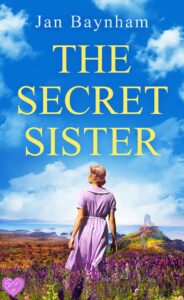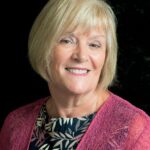The Secret Sister By Jan Baynham
20 November 2023
 We are delighted that you could join us to talk about your new release. Could you tell us a little more about it? The Secret Sister is my fourth novel and was published by Joffe Books/Choc Lit Publishing on August 31st. It’s a dual narrative, dual timeline that explores secrets, forbidden love, grief, sibling relationships and forgiveness. Set in wartime Wales and 1960s Sicily, the book opens in 1942 when Carlo Rosso arrives at a prisoner of war camp in the heart of mid-Wales. From the start, there are hints that he will not be able to return to his native Sicily when the war is over. He leaves camp each day to work for a local builder where he notices a young widow, Sara, who works in the office. Even though fraternisation between the prisoners and local women is prohibited, there is an instant attraction between them. Longing looks soon turn into love letters and a connection neither of them can deny. As their love grows, so does the danger all around them.
We are delighted that you could join us to talk about your new release. Could you tell us a little more about it? The Secret Sister is my fourth novel and was published by Joffe Books/Choc Lit Publishing on August 31st. It’s a dual narrative, dual timeline that explores secrets, forbidden love, grief, sibling relationships and forgiveness. Set in wartime Wales and 1960s Sicily, the book opens in 1942 when Carlo Rosso arrives at a prisoner of war camp in the heart of mid-Wales. From the start, there are hints that he will not be able to return to his native Sicily when the war is over. He leaves camp each day to work for a local builder where he notices a young widow, Sara, who works in the office. Even though fraternisation between the prisoners and local women is prohibited, there is an instant attraction between them. Longing looks soon turn into love letters and a connection neither of them can deny. As their love grows, so does the danger all around them.
Twenty-five years later, their daughter, Claudia, holds her father’s hand as he takes his last breath and whispers a name: Giulietta. The mystery deepens when she finds an old photograph of a young woman and a baby and asks herself, who are they and who is Giulietta? She travels to Sicily to find out and the secrets of the past collide as the family is shaken to its very core when she uncovers the truth.
What was the inspiration behind your book? What prompted you to tell this story? During WW2, there was a prisoner of war camp not far from where I was born and brought up and the area of Wales where I partially set all my novels. Several of the prisoners stayed in Wales when war ended and married local girls. When I was thinking of ideas for the novel, the character of Carlo was formed fairly quickly. I wanted him to be an Italian POW with a secret who gets involved with a local woman and their story would be fraught with all the dilemmas and dangers that could entail. When researching prisoner of war camps, l read about a beautiful Italian Chapel at Lamb Holm on the island of Orkney created by the POWs themselves. They converted an old Nissen hut into a place of beauty in which they could practise their Catholic faith. The pictures of what they had created from found and scrap materials were stunning. This information, and especially the images, inspired me to make Carlo an artist before he was conscripted into the army and become the natural choice to lead a team to build a similar chapel in my fictional camp. I like to think that by telling Carlo and Sara’s story, it reinforces the fact that war affects everyone, ordinary people who did not choose to go to war and may not, as in the case of Carlo, share the views of their leaders.
How did you decide on the names for your characters and the setting for your book? I always enjoy choosing names for my characters. I think it’s very important to be conscious of the time in which the novel is set as well as its location. For the Welsh setting, when I chose Welsh names, I wanted them to be easy for my readers to pronounce – Sara, Menna, Aled. I Googled popular names in a certain year, mindful that in 1942, for characters in their early twenties, it would be the 1922 -1925 list that would be most useful – Fred, Margaret (shortened to Peggy), Nell, Edna. For the Italian names, I tried to make sure that the ones chosen would often be heard in Sicily – Carlo, Alessandro, Matteo, Claudia, Maria, Rosa.
As always, the setting of my novel is fictional but based on real places. When the novel is taking place in mid-Wales, I choose place names that are easy to say; the main town is Pencraig (top of the rock), the village where Claudia lives is Dolwen (white meadow) and the tiny hamlet where the prisoner of war camp is situated is named Pont Ithon (bridge on the Ithon). When the story moves to east Sicily, I named the main town as Porto Montebello, roughly meaning the port of the beautiful mountain in honour of Mount Etna which is close to where I imagined my town to be and Villaggio delle Rocce, roughly meaning village of the rocks, is where Alessandro has his studio.
What was your journey to publication? I didn’t start writing any fiction until I retired so I had a lot of catching up to do! After joining a small writing group in a local library, I began writing short stories. Wanting to know more about the craft of writing, I took courses at Cardiff University, shorts to start and then moving on to novel writing. The best decision I made was to join the RNA’s wonderful New Writers’ scheme in 2016. Without the helpful advice and encouragement from my readers, I’m sure I would not be a published author today. A huge thanks to them whoever they are! I began submitting and received the inevitable rejections. To start with, they were the ‘thanks but no thanks’ type of response, but soon I began receiving feedback telling me why my novel had been rejected and offering suggestions that enabled me to work on the advice and improve my submissions. I was delighted to receive a three-book contract from Ruby Fiction in May 2019 and the rest is history, as they say!
Where did your research for the book take you? It was a joy to undertake research for The Secret Sister. After the restrictions of COVID when most research had to be done online, for this book I was able to visit locations and see places and artefacts in real life. Hut 9 Island Farm Camp, Bridgend, is a former German POW camp and is open to the public at various times of the year. Although no Italians were housed there, it still gave me a sense of what it must have been like to be imprisoned. The range of artefacts from the time was extensive and I was able to use what I’d learned when writing the novel. Although I was not able to travel to the Italian chapel in Orkney, I did visit another one in Henllan, near Llandyssul, in West Wales. The prisoners there, like those in Orkney, were given permission to convert a Nissen hut into a place of worship. I was amazed at the ingenuity of the men when I saw what they had created from readily available and scrap materials, including wooden packing cases, empty bully-beef tins and cement bags. The walls were beautifully illustrated with paints made with natural dyes. It was stunning and the visit greatly influenced my writing of Carlo’s scenes in the book. The highlight of my research was a trip to Sicily. Once there, I was able to walk in the footsteps of Claudia as she visited for the first time, sampling the wonderful food and weather, meet local people and marvelling at the vibrant colours of the island. I had prebooked two tours; one was to enter the underground tunnels under a Jewish synagogue in Syracuse which people used as shelters to protect them from the Allied bombing and the second was to visit Casa Cuseni, a beautiful villa in Taormina. Not only enjoyable, visiting Sicily itself has I hope given the novel an authentic sense of place.
What book do you wish you had written? There are so many wonderful books out there that it was almost impossible to choose just one. However, every now and then, you read a novel that you didn’t want to end and one that you wish you’d written yourself. That happened to me when I finished Letters to the Lost by Iona Grey. It was the winner of the Romantic Novel of the Year in 2016 and I can see why. It moves effortlessly from wartime to present and in both narratives, the characters come alive on the page. You are drawn into their emotions and get glimpses of times past and present. As a reader, you become wrapped up in a beautiful, tender love story and are left thinking about Stella and Dan long after finishing the book. If one of my books had that effect on a reader, I would be over the moon!
Can you tell us what you are working on now? I’ve started planning and researching my next novel. It will be partly set in mid-Wales and Kefalonia at the time of its devastating earthquake in 1953 and twenty years later for the twentieth anniversary. It’s the story of a five-year-old little girl who is pulled from the rubble, her family’s only survivor. The novel will explore secrets, identity, trauma, sibling relationships and first love. I first visited Kefalonia in 2019 and fell in love with the island. A return there in the form of a research trip is definitely on the cards for 2024!
About the Author
 Born and brought up in the heart of mid-Wales, Jan lives on the outskirts of Cardiff with her husband. They have three grown up children and five grandchildren. She started writing when she retired after a career in teaching and advisory education. As a member of the RNA, she values the friendship and support from other members and regularly attends conferences, workshops, talks and get-togethers. She is an active member of her local chapter, Cariad. When not writing, she enjoys reading, family history, Pilates and looking after her grandchildren.
Born and brought up in the heart of mid-Wales, Jan lives on the outskirts of Cardiff with her husband. They have three grown up children and five grandchildren. She started writing when she retired after a career in teaching and advisory education. As a member of the RNA, she values the friendship and support from other members and regularly attends conferences, workshops, talks and get-togethers. She is an active member of her local chapter, Cariad. When not writing, she enjoys reading, family history, Pilates and looking after her grandchildren.
Purchase links
https://www.amazon.co.uk/Secret-Sister-breathtaking-family-sixties-ebook/dp/B0CD86JDLF/
https://www.amazon.co.uk/Jan-Baynham/e/B085DC6BKR/ref=dp_byline_cont_ebooks_1
Social media links
Twitter – @JanBaynham (https://twitter.com/JanBaynham)
Facebook – Jan Baynham Writer (https://www.facebook.com/JanBayLit/?locale=en_GB)
Instagram – janbaynham (https://www.instagram.com/janbaynham/?hl=en-gb)
Blog – Jan’s Journey into Writing (https://janbaynham.blogspot.com)



